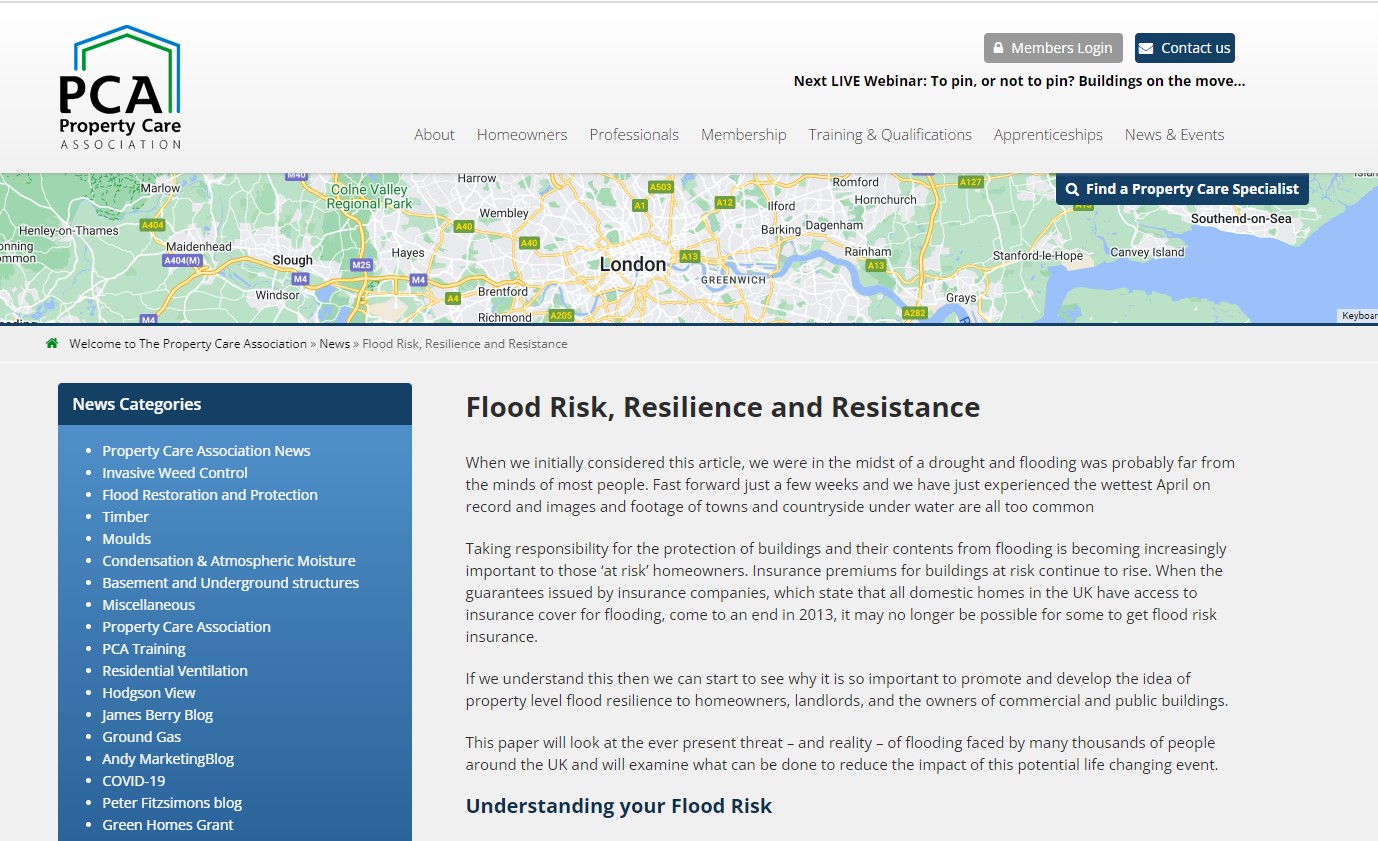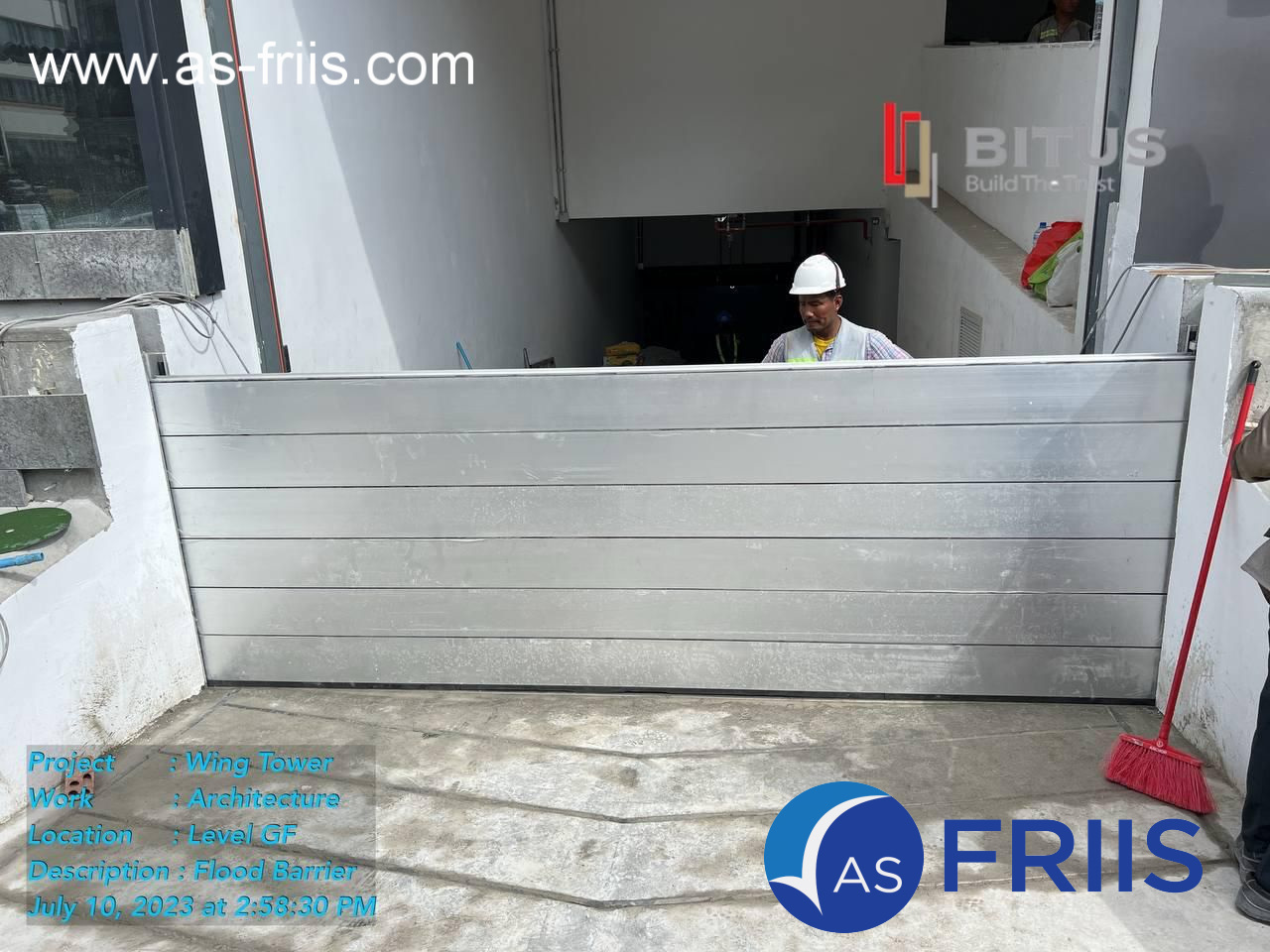When we initially considered this article, we were in the midst of a drought and flooding was probably far from the minds of most people. Fast forward just a few weeks and we have just experienced the wettest April on record and images and footage of towns and countryside under water are all too common
Taking responsibility for the protection of buildings and their contents from flooding is becoming increasingly important to those ‘at risk’ homeowners. Insurance premiums for buildings at risk continue to rise. When the guarantees issued by insurance companies, which state that all domestic homes in the UK have access to insurance cover for flooding, come to an end in 2013, it may no longer be possible for some to get flood risk insurance.
If we understand this then we can start to see why it is so important to promote and develop the idea of property level flood resilience to homeowners, landlords, and the owners of commercial and public buildings.
This paper will look at the ever present threat – and reality – of flooding faced by many thousands of people around the UK and will examine what can be done to reduce the impact of this potential life changing event.
Understanding your Flood Risk
It is important, initially, to establish the flood risk; this is the likelihood of a flood occurring and the potential damage it could cause.
There are a number of services that can be used to assess buildings at risk from flood water. Perhaps one of the most helpful is that of the Environment Agency, whose website can be used to monitor flood warnings in real time.
It is also possible to check flood risk using the Homecheck website site. This is a service set up to assist those moving house, but contains very useful information of the flood risks associated with surface water flooding.
Most recently a useful campaign and website was launched to help users understand the importance of understanding and acting upon flood risk; www.knowyourfloodrisk.co.uk . This organization wishes to raise awareness of the issue of flood risk, and provide guidance to all communities across the public and private sectors in educating homeowners and businesses.
Understanding the Building
In order to understand the potential implications of a future flood, it is necessary to fully understand the construction of the building which may be affected.
Water affects different materials in a variety of ways. For instance, concrete and brick are very resistant to water damage. Timber can be resistant to short term wetting but decays when it remains wet for a long period. Dense materials retain little water but dry slowly, whereas porous materials can retain large amounts of water but can often be dried quickly.
Historic repairs and alterations can affect the way a building is recovered. For instance, the presence of a chemical damp proof course can indicate a previous problem with rising damp. Previous issues with dry rot in a building may substantially increase the risk of future outbreaks if the building structure becomes wet again.
Some types of construction and the addition of extensions can result in voids being created within the fabric of a building. Insulation products below floors and within walls must also be a consideration as they can retain flood water and may have to be removed if they are made wet.
Consideration
As and when buildings, and the risks posed by flooding, have been properly assessed, it is important to evaluate the options available and decide on a course of action.
If the building is at relatively low risk of flooding, it may be considered uneconomic or unnecessary to spend money on flood protection measures. In these situations it is likely that insurance premiums to cover flooding will not be excessive.
Conversely, if it decided that such protection measures should be put in place, the choice then has to be made between ‘flood resilience’ or ‘flood resistant’ remedies. Flood resistance is the use of structures to prevent the entry of water into the building. Flood resilience is the use of products and practices that are aimed at making the building resilient to the effects of floodwater that has entered the building.
It may not be possible to make an existing building totally flood proof, but very high levels of water resistance and flood resilience can be achieved. It is possible to create a perfectly dry, habitable underground room in a building where the walls were once completely saturated and running with water. In most situations it is usually effective to use measures that offer a combination of both resistance and resilience.
Flood Resistance
Put simply, these are any measures installed onto or into a building in an attempt to keep water out. There are many practical steps that can be taken – some are relatively inexpensive but some require substantial investment. Before any flood resistance measures are implemented, it is important that the property is stable and is able to resist the additional loads that may be placed on it, be it any head of water. If there is any doubt, it is important to consult a structural engineer who can provide advice and guidance. As a rule however, it is commonly considered that most reasonably built masonry structures should be able to resist the pressure of 0.9 metres of standing water.
Renders and other coatings can be applied to the external surfaces to restrict water ingress. In recent years, silicone-based products have been developed that significantly improve the water resistance of porous masonry even under considerable hydrostatic pressure.
Openings that allow ventilation and service access such as pipes and cables can pose a problem when flood water arrives. These can usually be dealt with by good sealing and the use of specially designed vents and air bricks that close automatically as water levels rise. As the flood overwhelms drains and sewers, it can back up to emerge out of toilets, sinks, drains and manholes. These can all be protected by using non-return valves in drains and pipe runs or by careful sealing around vulnerable inspection chambers. A wide range of products and devices are now available and can be easily installed by the appropriately skilled and experienced trade’s people.
Larger openings such as doors and windows can be protected using flood barriers or specially designed flood proof doors. These vary widely in both cost and ease of installation but if fitted in combination with other flood resisting elements can provide an excellent means of keeping water out.
The use of technology and techniques more commonly seen in underground waterproofing can be used to build in flood resistance. This may include the use of cement base “tanking” products applied to solid walls and floors and/or the use of high density cavity drainage membranes that are used to manage any water that gets though the building’s external fabric. This water is then directed to a point where it can be pumped out of the property without causing damage.
It should be noted that most of the flood resistant measures described above rely on a strong serviceable solid ground floor being present. Where wooden floors exist, water may be pushed through the soil below the suspended floor that then overwhelms the property from within. In such situations it may be necessary to consider sealing the ground below the floor, installing pumping equipment in the sub floor space, or replacing timber floor with concrete.
In a limited number of situations, it may be possible and cost effective to install permanent or temporary barriers around the building to keep flood water from contacting the structure at all. These can, however, be expensive and may take skill and time to erect in the event of a flood but should be a consideration where space allows and the impact of a flood could cause great financial or cultural loss.
It is important to remember that almost all of the floor resistant measures listed above will require routine maintenance and annual checking to ensure that critical components are in good shape for when they are put to the test.
Flood Resilient Repair
In any situation where a property has been flooded, or is at significant risk of flooding, measures can and should be taken during construction or any refurbishment to help the building and its owners recover following a flood. These actions should not significantly increase the cost of work but can reduce the time it takes to recover a building after flooding and lessen the human impact of the event.
The flood resilience of most existing buildings can be improved by the use of a range of very simple measures.
The use of building materials and techniques that will not be affected by water and that assist in the recovery of the building following flooding. This may include tiling walls and floors over rendered or solid surfaces.
Features that contain elements that have very poor durability, such as gypsum plasterboard, MDF and particle board, should be replaced with products that are tolerant of water and can be easily cleaned. This may include water resistant wall boards, kitchen cabinets that have steel or plastic frames and solid internal doors.
It may be possible to incorporate drainage points into the ground floor so that flood water can be easily evacuated after the water has receded.
Electrical and plumbing services can be positioned at high levels so that they remain above the level of all but the very worst floods.
The list of possibilities is endless but even the simplest and least costly of these measures may have a significant effect on the time that is needed to recover, repair, and reoccupy the building.
Conclusion
Unfortunately, all the insurance cover or sympathy in the world will not make up for the anguish most people will experience if their homes or businesses flood. It follows, therefore, that we should all know and understand our flood risk and take steps to protect ourselves from the impact of a catastrophic flood if we find ourselves in a high-risk area.
It is possible to improve both the flood resistance and flood resilience of almost every at-risk property in the UK. With a little careful thought, some knowledge and a measure of well-directed money, a great deal can – and has – been achieved. The impact and implications of a future flood should be considered whenever a house is built, repaired or refurbished.
Much has been written about drying and the recovery of flood damaged building, including the Property Care Association’s own Code of Practice for the recovery of flood damaged buildings. For further information, contact the Association on 0844 375 4301 or the original article here





